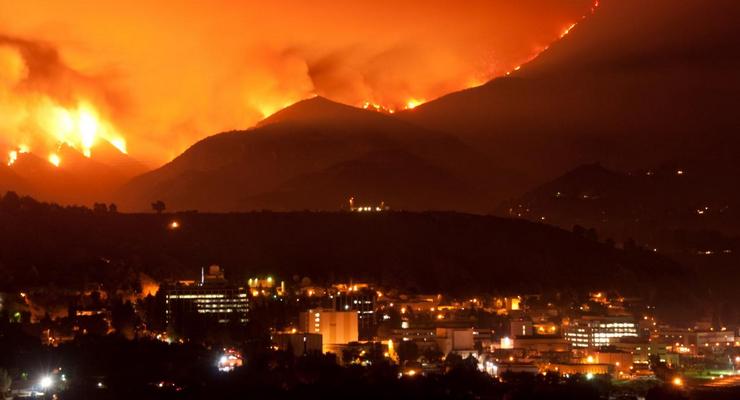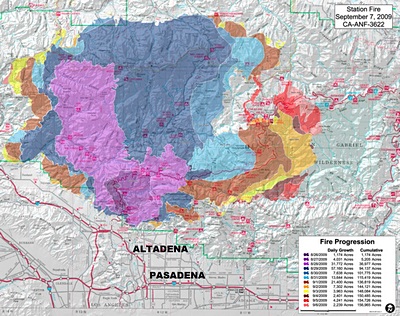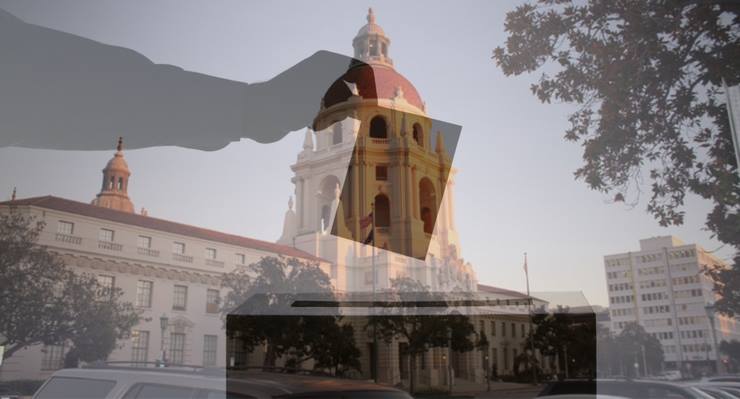
Los Angeles County was struck by its largest wildfire in recorded history just under nine years ago when the Station Fire devastated 250-square-miles of forest in the San Gabriel Mountains, forced evacuations in Altadena and Pasadena and killed two firefighters. While firefighting technology and tactics have evolved and improved since 2009, years of drought have left the Angeles National Forest packed with kindling, and fire officials say the possibility of another massive blaze in local foothills is now very real.
Officials said it was ignited by an unidentified arsonist near a U.S. Forest Service Station along Angeles Crest Highway on Aug. 26, 2009. It a was not fully contained until a month-and-a-half later. 90 homes were destroyed, along with another 120 buildings.
On Monday, Angeles National Forest Fire Chief Robert Garcia said the forest is already extremely dry and flammable, and it will only get worse in the coming weeks.

“There’s always a risk of an unplanned wildfire in terms of the conditions relative to the 2009 Station Fire,” he said.”As we go later in the summer, the fuel conditions and the rest of the condition of the vegetation continues to degrade in terms of live fuel moisture.”
Firefighters in Northern California have their hands full with a series of ongoing wildfires, including the deadly “Carr fire” in Shasta County, which has claimed eight lives, scorched 176 square miles, and destroyed 965 residences, 16 commerical structures, and 397 outbuildings.
The daily weather and a combination of other shifting factors also determine the level of fire danger on any given day, according to Garcia. The drought that’s dragged on for more than half a decade is a big concern to firefighters.
Despite an unusually wet 2017, “The (drought) effects are cumulative, “ he said.
“It makes the vegetation more susceptible to insects and disease. So it kind of is a combined effort. And you can see what we call tree mortality. High levels of [forest] dieback… and that has a compounding effect as you can see playing out,” Garcia explained.
Pasadena Emergency Services Coordinator and spokesperson Lisa Derderian said she’s also worried about the drought’s potential to spawn a fire of the Station Fire’s magnitude.
“The risks are as great if not greater due to years of drought since 2009,” she said.
Derderian said heavy rains last year, followed by hot and dry conditions this year, “have created increased vegetation growth that is now tinder dry.”
But fire officials have learned a few new tricks over the past nine years, including lessons taken directly from the Station Fire.
For one, the U.S. Forest Service has resumed flying fire-fighting aircraft at night, Garcia said. Lawmakers and others questioned whether air support in the early days of the Station Fire could have helped it from growing as large as it did.
The Forest Service previously had flown night operations, but stopped the practice in 1977 following the death of a pilot. In the wake of the Station Fire, the decision was reversed. Night flights resumed in 2013.
“And so the Angeles National Forest is home to one of the only helicopter night flying programs in the U.S. Forest Service program or system. And it also includes a night aerial supervision platform, which is a fixed-wing aircraft that provides real-time supervision to multiple aircraft flying at night, as well as reconnaissance and intelligence gathering capability, Garcia said.
“This aircraft can, in real time, provide infrared mapping and intelligence gathering tools to send to commanders on the ground, and both those assets are new since 2009,” he said.
“We’re constantly learning from other conditions and adapting management practices and tools and methods and so on,” the Chief said.
He said the agency had “dramatically” stepped-up abatement of hazard fuels, including fuel breaks, defense zones and defensible space around buildings.
“We’ve taken a wider approach to the defensive space, including allowing private property homeowners that are adjacent, or in holdings within the national forest, to come on to the National Forest to obtain state and county standards for defensible space, including beyond their property,” he said. “So that’s one really significant change since 2009.”
Derderian said the Pasadena Fire Department has also seen upgrades over the past decade.
“There are enhancements in firefighting apparatus, personal protective equipment and tactics and strategies taken from lessons learned since 2009,” she said. “We also have improved radio interoperability with regional communication plans. We constantly evaluate our training and add additional training requirements annually.”
Garcia said he believed public awareness about wildfire risk and planning is greater today because the Station Fire impacted so many people.
“But we’re constantly trying to drive that message home because we have quite a variety of users with the National Forest. Everything from commuters that commute on a daily basis to recreationists to those that occupy the National Forest for different types of uses,” he said.
“So it’s definitely a balancing act to ensure that people remember those lessons from the Station Fire, and then we’re such a diverse community that we have users and adjacent homeowners that continuously move into the area from outside of the area who you have to remind how devastating that fire was.”
When visiting the forest, Garcia urged the public to pay attention to the often-changing fire danger level and obey rules such as campfire restrictions.
“We have a mantra: we ask the public to ‘know before you go,’” Garcia added. “Check our website before you go out.”
Information on fire danger, as well as other forest information, is available online at fs.usda.gov/angeles.

















